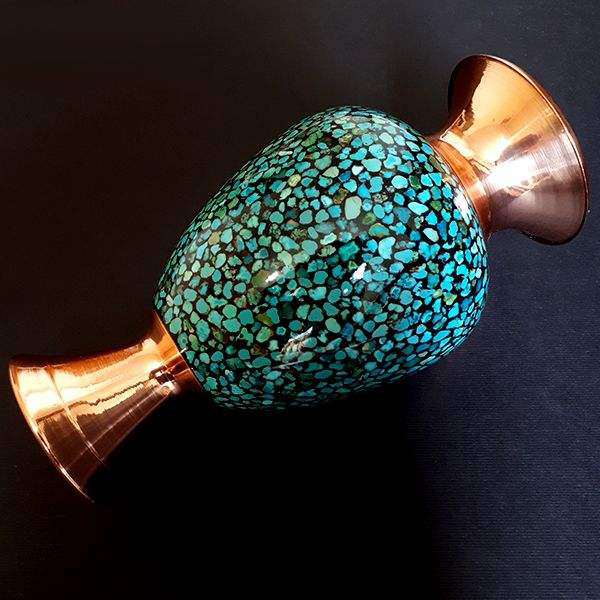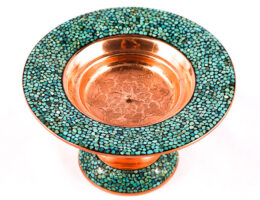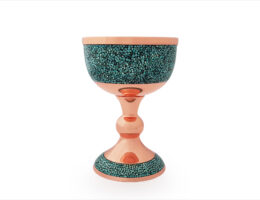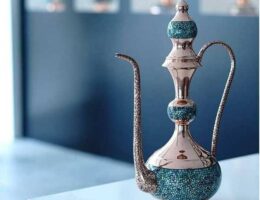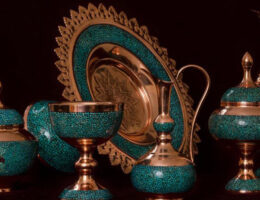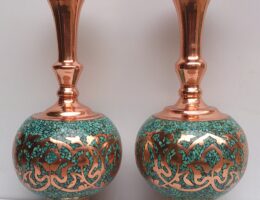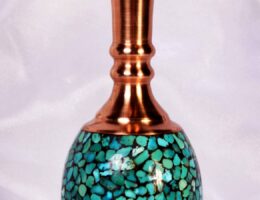IRAN ART EXHIBITION: THINGS YOU DIDN’T KNOW ABOUT TURQUOISE!
As the name suggests, this art involves using turquoise stone, one of the world’s most beautiful gemstones. The blue turquoise stone and dark turquoise stone is found in Egypt, Mexico, and Iran, with mesmerising hue to the copper in its makeup. Still, Iran is home to the oldest and biggest turquoise stone mine globally, which is located in Neyshabur, Razavi Khorasan Province, northeast of the country.
Inlaid Turquoise jewelry and Home Accessories
Although seen on the exterior of some old places of worship in Iran, turquoise is mainly used in jewellery making as:
• turquoise rings
• turquoise earrings
• bracelets, and other items.
Isfahan artists use the gemstone on copper surfaces, creating beautiful handicrafts called “turquoise inlays.”
Turquoise inlay products
• Turquoise inlay vases
• Framed turquoise inlay
• Turquoise inlay jewelry
• Turquoise inlay lidded bowls
• Turquoise inlay tea sets
• Turquoise inlay mirrors
• Turquoise inlay trays
• Turquoise inlay cake/dessert stands
• Turquoise inlay copper sugar cube bowls
Benefits of turquoise stone!
IRAN ART EXHIBITION: Many who use turquoise products, especially jewelry, do so for the therapeutic benefits of the beautiful gemstone. Just like agate, turquoise has numerous benefits, such as:
• Relieving stress and depression
• Alleviating phobias
• Boosting mood and attracting good luck
• Improving eyesight, circulation, and throat health
• Treating many internal diseases!
• Stimulating and activating chakras
• Relaxation
• Awakening inner forces
• Relieving headaches and migraines
• Treating epilepsy
Mental benefits of turquoise!
A symbol of peace, turquoise improves mental health in many ways, including:
• Enhancing love, compassion, honesty, and reasoning
• Protection against negative energy
Fun facts about turquoise
• Turquoise comes in a wide range of colors, comprising more than 100,000 shades of blue and green!
• No two turquoise stones are alike in terms of hue and texture; each is unique as a fingerprint.
• Turquoise uses oxygen!
Price of the Persian Turquoise
Irrespective of whether you want to buy turquoise utensils or jewelry, the most important factor in determining the price is the size, order, and accuracy of the work.
In general, the bigger the work, the higher its price. Because more materials have been used and it has taken more time to build.
Second, the work should be accurate and well-organized. The Persians are known for their precision in stamping turquoise. However, different types of turquoise stamping differ very little in terms of clean work. Overall the price of Turquoise is something around $200 and $2,000.
Steps of turquoise inlay in Decorative Dishes
IRAN ART EXHIBITION: Here, we’ll take a look at the steps taken in making a work of turquoise inlay:
1. Preparing the copper base: After a turquoise inlayer design a product, the procedure goes to a coppersmith to make the base. The copper object is then given ridges and grooves along its surface using bending machines.
2. Gluing turquoise pieces: The turquoise inlayer meticulously glues tiny pieces of turquoise on the base.
3. Polishing and finishing: In this step, the product is polished using a diamond blade. Then, it’s finished by sanding and coated in a layer of polyester powder to make the copper washable. The final product will be a copper object covered partially with a mosaic of turquoise pieces.
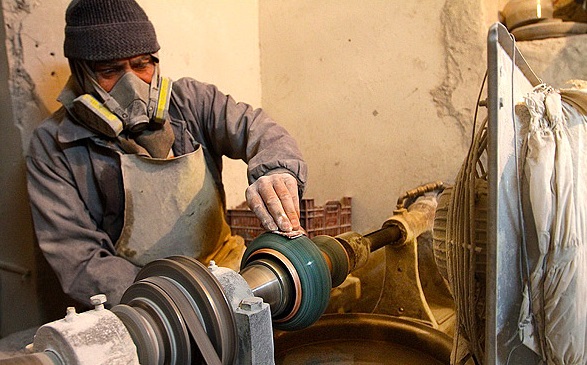
Authentic turquoise stone vs fake one
How to distinguish authentic art has always been an issue for art enthusiasts. Here, we have identified six ways to tell genuine from fake turquoise inlay. Here’s how to do it:
1. Scratch the turquoise with a needle: If the stone is scratched, then it’s no doubt made of plastic. Fine turquoise can never be scratched.
2. Check attention to detail: The more meticulous the inlaying, the more valuable the piece. Also, the more turquoise pieces are used and the more organized they are inlaid, the higher is the product quality and value.
3. Compare turquoise and glass hardness: Turquoise is harder than glass, so it can scratch it. Use a piece of turquoise to scratch glass. If the glass doesn’t get scratched or the stone does, then the stone isn’t original turquoise.
4. Use polyester: Rub some polyester on the turquoise. If the stone is scratched, then it’s not turquoise.
5. Expose to sunlight: Expose the turquoise to direct sunlight for a few minutes. If the color doesn’t change, it’s probably original turquoise, as fake turquoise changes in color when exposed to sunlight.
6. Expose to fire: Hold the turquoise close to a fire. If the stone changes in color, it’s not genuine because the fire can’t change the color of true turquoise.
Which Iranian cities produce turquoise inlay?
IRAN ART EXHIBITION: The northeastern cities of Mashhad and Neyshabur in Razavi Khorasan Province together form the cradle of turquoise inlay. The art originated in Mashhad and gradually found its way to Isfahan. Today, turquoise inlay artists are mostly centered in Mashhad, Neyshabur, Isfahan, and Zanjan.
What countries is Persian turquoise inlay exported to?
Italy, Iraq, the UAE, Germany, Bahrain, Malaysia, New Zealand, Sri Lanka, Oman, Brazil, Jordan, France, Georgia, Kenya, Lebanon, Canada, the US, Nigeria, and Austria are the destinations of Iran’s turquoise inlay export.
